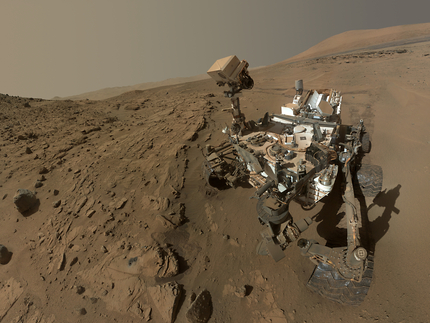After more than two years and a dangerous trek of about six miles, NASA’s SUV-sized, robotic rover has made its first drill into Mount Sharp — the geologic site scientists have been focused on since before Curiosity landed on Mars.
The rover, however, has been far from idle. In the last two years, it has drilled holes , sampled soil and rocks and even found evidence of ancient water flows on the surface of the Red Planet.
That work was largely prelude to the current mission, its next and potentially most significant scientific phase.
“We’re putting on the brakes to study this amazing mountain,” said Curiosity deputy project manager Jennifer Trosper. “Curiosity flew hundreds of millions of miles to do this.”
According to NASA, Curiosity late on Wednesday used its hammering drill to dig about 2.6 inches into a basal-layer outcrop on Mount Sharp. The rover then collected a sample of powdered rock and is holding it in its robotic arm.
The next step in Curiosity’s research will be to move the sample into a scoop on the rover’s arm. There, it can be studied to determine whether it safely can be put through a sieve, portioned out and delivered to the rover’s scientific instruments – such as its chemical or mineralogical analysis instruments – without clogging them.
“This drilling target is at the lowest part of the base layer of the mountain, and from here we plan to examine the higher, younger layers exposed in the nearby hills,” said Curiosity deputy project scientist Ashwin Vasavada. “This first look at rocks we believe to underlie Mount Sharp is exciting because it will begin to form a picture of the environment at the time the mountain formed, and what led to its growth.”
Scientists are not sure how far up the mountain the rover will get, but hope to take samples along the way.
Mount Sharp has been the primary focus of Curiosity’s mission because, like the Grand Canyon, scientists can see the geology of different historical time frames by looking at each layer of the mountain. Sharp should give scientists clues to what’s been happening on the planet’s surface in the last few millions of years.
Researchers hope the different rocks and geology the rover finds will offer clues about whether Mars once was able to support life, even in microbial form.
It’s been a busy week on Mars.
Several days ago, NASA’s MAVEN spacecraft, after a 10-month journey and 442 million miles, reached Mars and slipped into its orbit. MAVEN is the first spacecraft dedicated to exploring the planet’s upper atmosphere, hopefully giving scientists clues as to why Mars didn’t hold onto its water and become a lush planet like Earth.
Just days later, the Indian Space Research Organization’s Mars Orbiter Mission, or MOM, reached Mars, fired its engines and maneuvered itself into orbit around the planet.
Computerworld








Subscribers 0
Fans 0
Followers 0
Followers